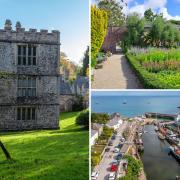Walter Langley (1852 – 1922) was one of the Newlyn School - the colony of artists who settled in the fishing village from the 1880s
Time Moveth Not, Our Being Tis That Moves
Walter Langley (1852 – 1922) was one of the Newlyn School - the colony of artists who settled in the fishing village from the 1880s, attracted by the clear, even light and dedicated to painting the hard-working lives of the people who lived there. Walter Langley mainly painted in watercolour, portraying scenes of everyday life in a small fishing village, highlighting the hardships and tragedies that were commonplace during that period.
For many years Time Moveth Not, Our Being tis That Moves’ hung in a private home but now forms part of the public collection of Newlyn School paintings at Penlee House, less than a mile from where it was originally painted. The model is believed to be a local woman called Grace Kelynack.
The artists of the Newlyn School were drawn not only by the pure natural light of the area, but also by the traditional way of life of the local fishing communities which was so often reflected in their work.’ says HLF’s Head of South West, Nerys Watts. We were delighted to have the opportunity to help bring back this wonderful example of that work to the place where it was first created, enabling local people and visitors alike to see and appreciate it.’
The picture was purchased from the estate of Ronald and Beryl Middleton, a couple from the West Midlands, who acquired the picture at auction in the early 1950s. Until the mid-1990s it was thought to be lost’ until the Middletons chanced upon Penlee House and revealed its whereabouts.
After a long wait, the picture has finally come home.
Where to see it: Penlee House Gallery & Museum, Penzance TR18 4HE penleehouse.org
Purchased in 2014 with funding from the Heritage Lottery Fund, the Art Fund, the ACE/V&A Purchase Grant Fund and the Friends of Penlee House



























